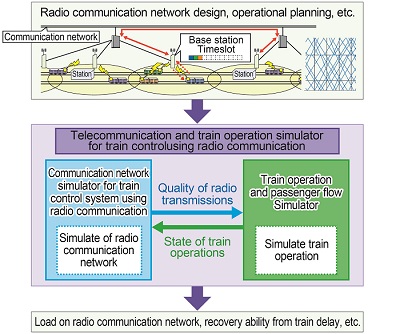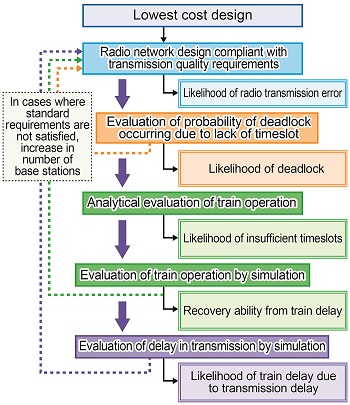23. Communication network and train operation simulator for designing train control system using radio communication
In train control systems using radio communication , a section is predefined as a “zone” by each base station and the base stations communicate with multiple trains located in their zone at the same time. Each base station allocates “timeslots” which are brief windows of time given to each train to be able to communicate in real time. When traffic density is very high and there are not enough timeslots for each train, trains without allocated timeslots are forced to stop. Therefore, when radio communication networks are designed, it is necessary to take into account both transmission quality and the need to avoid train delays due to lack of timeslots. Up until now, radio communication network design focused solely on transmission quality, which meant that excessive communication capacities were provided to endure stable transportation service.
Consequently, RTRI developed a “Telecommunications and train operation simulator for train control systems using radio communication” which evaluates transmission quality taking into account train operations. This method combined the “Train communications network simulator for train control systems using radio communication” for evaluating the stability of transmission quality of the train control systems using radio communication with “Train operation and passenger flow simulator,” both previously developed by RTRI (Fig.1). It is now possible to quantitatively evaluate the load on radio communication networks, and train delays not only for ordinary but also for disrupted situations which represent severe operating conditions for train control systems using radio communication. A method was also devised to detect sections vulnerable to deadlocks which force trains to stop due to lack of timeslots.
In addition, a flow chart was produced for designing radio communication networks using the developed simulator, etc. (Fig. 2). When new train control systems using radio communication are introduced, this flow chart will make it possible to ensure that the designs satisfy the need for transmission quality and capacity to recover from train delays. It can also ensure the lowest cost design for radio communication networks.
Other Contents
- 21. Active bogie angle steering system ensuring both running stability and reduced lateral force
- 22. Improvement of the effectiveness of tunnel entrance hoods by enlargement of their cross-sectional area to reduce micro-pressure waves
- 23. Communication network and train operation simulator for designing train control system using radio communication
- 24. Method for supporting decisions on planning Shinkansen transport services based on forecast demand fluctuations
- 21. Active bogie angle steering system ensuring both running stability and reduced lateral force
- 22. Improvement of the effectiveness of tunnel entrance hoods by enlargement of their cross-sectional area to reduce micro-pressure waves
- 23. Communication network and train operation simulator for designing train control system using radio communication
- 24. Method for supporting decisions on planning Shinkansen transport services based on forecast demand fluctuations


